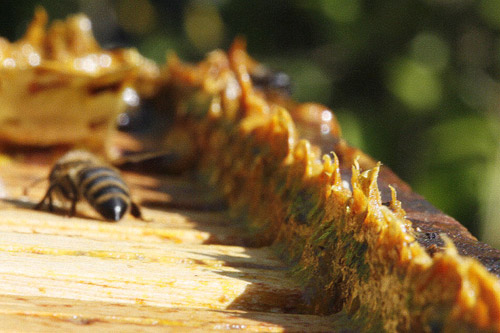Erika Passone, Erica Lombardi
INTRODUCTION
Propolis is a resinous substance collected by bees from tree buds and the cortex of the plants.It is then transformed in the final product by the addiction of beeswax, pollen and enzymes made by the bees.Historically, propolis was used in Greece to treat abscesses. The Assyrians also used propolis to heal wounds and tumors, while the Egyptians used it for mummification. Today, propolis is commonly found in chewing gum, cosmetics, creams, lozenges, and skin creams. It is frequently used in foods and beverages with the claim that it can maintain or improve health. Its function is to protect the hive from the cold winters drafts and rain. It is also believed to prevent diseases and parasites from entering the hive; it inhibits fungal and bacterial growth and prevents putrefaction within the hive. If bees can't carry out small animals who die in the hive, they seal the carcass in propolis, mummifying it and making it odorless and harmless. Its colour varies depending on its botanical source: the most common colours are yellow and black. Recent progress of propolis for its biological and chemical compositions and its botanical origin.April 2013

COMPOSITION
- resins (50%)
- wax
- fatty acids
- essential oils
- pollen
- minerals( Mg,Ca,I,K,Na,Cu,ZN,Mn,Fe)
- vitamins(thiamine , riboflavin , pyridoxal, ascorbic acid, vit E and vit P)
- enzymes(succinate dehydrogenase,glucose 6-phosphatase and acid phosphatase)
- acids(ATP, caffeic acid phenethyl ester ,phenol)
- benzoic acid derivates(salicylic acid,gallic acid)
- cinnamic acid derivates (caffeic acid,ferulic acid)
- coumarins
- alcohols(benzylic alcohol,phenehtyl alcohol)
- aldehydes(vanillin,cinnamic)
- flavonoids
- terpenes
- aminoacids
- ketones
- sterols,polysaccharides,lattons)
Propolis is used by the bees to seal the beehive where the deposition of the eggs and the feeding of the larvas take place.It is also used to protect and build the hive. We use propolis mainly for its antibiotic and antiviral properties.
MEDICAL PROPERTIES
antibiotic
antimicotic
antiviral
anti-inflammatory
antioxidant
anesthetic
healing
antisepitic
immune stimulating
vasoprotector
antitumoral
A QUICK LOOK ON THE ENZYMES
SUCCINATE DEHYDROGENASE
It is a flavoprotein. It is the second complex of the respitatory chain. It is an enzyme complex on the inner mitochondrial membrane and it is involved in the citric acid cycle because it oxidates the succinate to fumarate.This can be done by the reduction of ubiquinone to ubiquinol. The enzyme complex is composed of four subunits, two hydrophilic and two hydrophobic. The hydrophilic subunit contains two different proteins:a flavoprotein and an iron-sulfur protein. The first one contains FAD and the succinate binding site. The second one contains three iron-sulfur clusters [2 Fe-2S],[4 Fe-4S], [3Fe-4S].

GLUCOSE 6 PHOSPHATASE
It is an enzyme found on the endoplasmic reticolum,that hydrolyzes glucose 6 phosphate to create a free glucose and a phosphate group.The glucose is exported from the cell by a transporter on the membrane . It is involved in gluconeogenesis and glycogenolys, so it is important in the omeostasis of hematic glucose.

ACID PHOSPHATASE
As its name says ,its role is to free phosphate groups bound to molecules during the digestion.We find it in lysosomes and it becomes active when the lysosomes fuse to the endosome,thanks to the decretion of ph.In the past itsserum levels were used to diagnose prostate cancer.
SOME EFFECTS
The antibiotic effect is represented for example by the action against Helicobacter Pylori . This is a gram - bacterium found in the stomach of patients with gastritis and gastric ulcers,but also with duodenal ulcers and stomac cancer. The caffeic acid phenethyl ester,a component of propolis, inhibits the peptide deformylase, which is used by HP to create polypeptide chains essential for its survival.
Caffeic acid phenethyl ester (CAPE), an active component of propolis, inhibits Helicobacter pylori peptide deformylase activity.2013 Propolis gives its aid in the treatment of depressive disorders and neurodegenerative illnesses like Parkinson and Alzheimer because it is a good inhibitor of the MAO Total monoamine oxidase (MAO) inhibition by chestnut honey, pollen and propolis.
October 2013 It is also known that propolis has antimicotic effect,in particular against Candida infections,saccaromycetes and parasites affecting human body.This action is due to caffeic acid phenethyl ester.
Propolis has shown promise in dentistry for dental caries and as a natural sealant and enamel hardener. The effectiveness of propolis against herpes simplex virus types 1 and 2 and parasitic infections has been demonstrated in early studies. Efficacy of Brazilian Propolis against Herpes Simplex Virus Type 1 Infection in Mice and Their Modes of Antiherpetic Efficacies.June 2011 However, well-designed studies are lacking, and further evidence is warranted in order to determine if propolis is effective for any health condition.
Numerous case reports have demonstrated propolis to be a potent allergen and sensitizing agent. Therefore, it should be used cautiously in allergic people. Toxicity with propolis is rare, although there are multiple case reports of skin irritation and itching, as well as blood vessel inflammation.
SIDE EFFECTS AND WARNINGS
The safety of propolis has not been thoroughly studied. Although there are several case reports of allergic reactions to propolis, it is generally believed to be well tolerated in most adults. Allergic reactions may cause swelling, redness, eczema, or fever. Propolis may irritate the skin and may cause burning, peeling lips, irritation, lesions, itching, swelling,psoriasis, or eczema. Case reports of irritation in and around the mouth have occurred after use of propolis lozenges or extract taken by mouth.
Toxicity data for propolis are limited. Early studies have found propolis to be relatively non-toxic.
ALLERGIES
Patients should avoid propolis if they have had allergic/hypersensitivity reactions to propolis, Populus nigra L. (black poplar), poplar bud, bee stings/bee products (including honey), or Balsam of Peru. There are multiple reports of swelling, fluid collection, redness, burning, eczema, fever, and other allergic reactions (including a severe allergic reaction called anaphylaxis) with repeated use of propolis on the skin. Propolis has been linked to several cases of contact dermatitis in beekeepers. Allergic contact cheilitis and perioral dermatitis caused by propolis: case report.2012